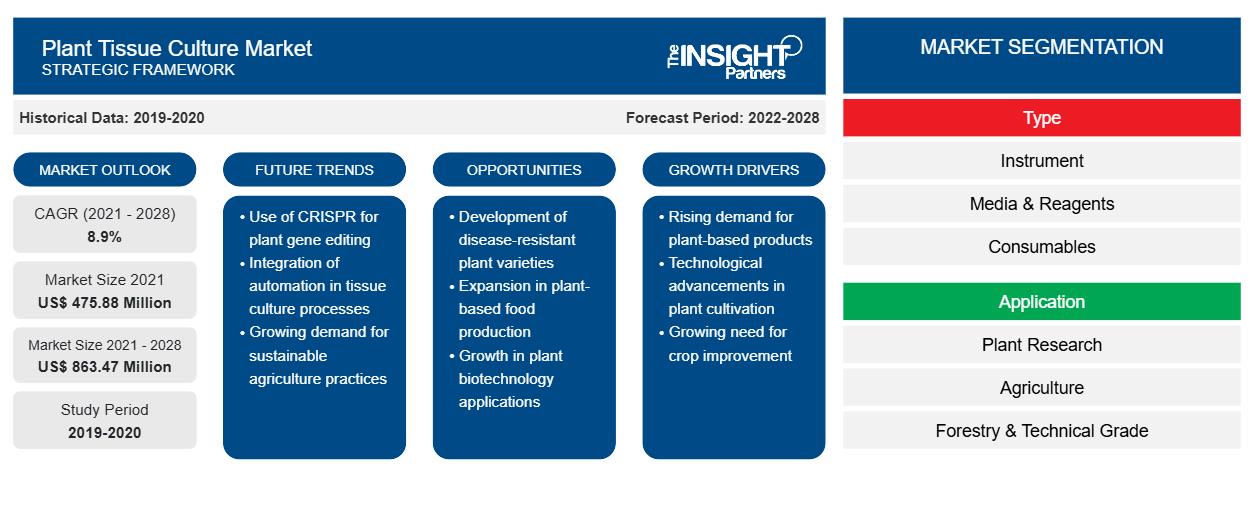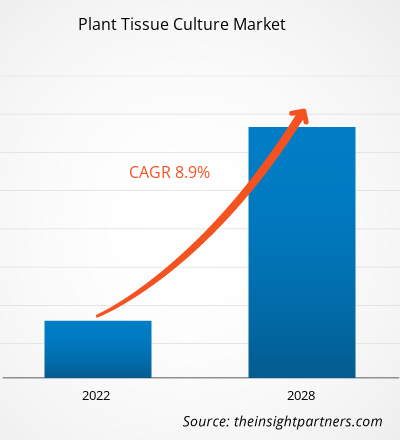Plant Tissue Culture Market Trends and Analysis by 2028
Historic Data: 2019-2020 | Base Year: 2021 | Forecast Period: 2022-2028Plant Tissue Culture Market Forecast to 2028 - COVID-19 Impact and Global Analysis By Type (Instrument, Media & Reagents, and Consumables), Application (Plant Research, Agriculture, Forestry & Technical Grade, and Others), and End Users (Greenhouse, Field, and Laboratory)
- Report Date : Nov 2022
- Report Code : TIPRE00029772
- Category : Life Sciences
- Status : Published
- Available Report Formats :


- No. of Pages : 201
[Research Report] The plant tissue culture market was valued at US$ 475.88 million in 2021; it is expected to grow at a CAGR of 8.9% from 2022 to 2028.
Plant tissue culture is a set of techniques used to grow plant cells, tissues, or organs under in vitro conditions on a culture medium of known composition. Clones of plants can be produced through micropropagation. Tissue culture enables the production of disease-free, high-quality planting materials. It also facilitates the speedy and uniform growth of plants. The increasing demand for transgenic plants and the proliferation of floriculture are the key factors driving the market growth. However, the high cost of tissue culture procedures hampers the market progress.
The plant tissue culture market is analyzed on the basis of technology, application, material, and geography.The report offers insights and in-depth analysis of the plant tissue culture market, emphasizing on various parameters such as market trends, technological advancements, and market dynamics, and the competitive landscape analysis of leading market players.
Customize This Report To Suit Your Requirement
You will get customization on any report - free of charge - including parts of this report, or country-level analysis, Excel Data pack, as well as avail great offers and discounts for start-ups & universities
Plant Tissue Culture Market: Strategic Insights

-
Get Top Key Market Trends of this report.This FREE sample will include data analysis, ranging from market trends to estimates and forecasts.
Market Insights
Increasing Demand for Transgenic Plants Bolsters Plant Tissue Culture Market Growth
Transgenic plants are those plants whose DNA is modified using genetic engineering techniques to introduce a new trait to the plant that does not occur naturally. These transgenic plants are generated using genetic engineering techniques in the laboratory by altering the genetic makeup, usually by adding one or more genes to a plant's genome. Transgenic plants are mainly developed to provide the necessary nutrients and cope with the food demand worldwide.
Millions of people suffer from malnutrition, which is more prevalent in developing and under-developed countries. According to World Health Organization (WHO), in 2019, approximately 462 million people were underweight. According to UNICEF, nearly half of all the deaths in children under five are attributed to undernutrition. Moreover, in 2020, about 45.4 million children under the age of five were wasted, and about 13.6 million out of these were severely wasted. According to Global Change Data Lab, in 2019, 8.9% of the world’s population was undernourished. Undernourished people are those who have calorie intake below minimum energy requirements. Researchers are focusing on developing transgenic plants that provide the required calories to meet these calorie requirements. The demand for transgenic plants is fueling the growth of the plant tissue culture market.
Type-Based Insights
Based on type, the plant tissue culture market is divided into instruments, media & reagent, and consumables. The instruments segment held the largest market share in 2021. However, the consumables segment is expected to register the highest CAGR during the forecast period. Instruments used in plant tissue culture include refrigerators, distillation plants, laminar air flow systems, weighing balance, incubators, centrifuges, sterilizers, etc.
Application-Based Insights
Based on application, the plant tissue culture market is segmented into plant research, agriculture, forestry & technical grade, and others. The agriculture segment accounted for the largest share of the market in 2021. However, the plant research segment is expected to register the highest CAGR during 2022–2028.
End User-Based Insights
Based on end user, the plant tissue culture market is segmented into greenhouse, field, and laboratory. The field segment held the largest share of the market in 2021. Moreover, the market for this segment is expected to grow at a CAGR of 9.2% during 2022-2028.
In many countries, COVID-19 had limited the mobility of people across borders and lockdowns had contributed to labour shortages for agricultural sectors, particularly those characterized by periods of peak seasonal labour demand or labour-intensive production. For example, travel bans within the European Union, as well as the shutting down of the Schengen Area, have significantly reduced the available workforce for the fruit and vegetable sector in a many of the European countries. Shortage of labour had lead to production losses and shortages in the market. The COVID-19 emergency had impaired the logistics, distribution and supply chains of horticultural products. This created food insecurity, due to breaks in the agricultural products supply chain and, consequently, large part of the population faced difficulty in accessing fresh food at reasonable prices Such aforementioned factors had a serious impact on the overall plant tissue culture industry.
Plant Tissue Culture Market Regional InsightsThe regional trends and factors influencing the Plant Tissue Culture Market throughout the forecast period have been thoroughly explained by the analysts at The Insight Partners. This section also discusses Plant Tissue Culture Market segments and geography across North America, Europe, Asia Pacific, Middle East and Africa, and South and Central America.
Plant Tissue Culture Market Report Scope
| Report Attribute | Details |
|---|---|
| Market size in 2021 | US$ 475.88 Million |
| Market Size by 2028 | US$ 863.47 Million |
| Global CAGR (2021 - 2028) | 8.9% |
| Historical Data | 2019-2020 |
| Forecast period | 2022-2028 |
| Segments Covered |
By Type
|
| Regions and Countries Covered |
North America
|
| Market leaders and key company profiles |
|
Plant Tissue Culture Market Players Density: Understanding Its Impact on Business Dynamics
The Plant Tissue Culture Market is growing rapidly, driven by increasing end-user demand due to factors such as evolving consumer preferences, technological advancements, and greater awareness of the product's benefits. As demand rises, businesses are expanding their offerings, innovating to meet consumer needs, and capitalizing on emerging trends, which further fuels market growth.

- Get the Plant Tissue Culture Market top key players overview
In 2022, North America held the largest share of the plant tissue culture market. The market growth in this region is attributed to a rise in research and development activities in the field of tissue culture. Moreover, Asia Pacific is expected to register the fastest CAGR during the forecast period. China, Japan, and India are the major contributors to the plant tissue culture market is this region. The market growth in APAC is attributed to increasing government investments in promoting tissue culture-based research, rising scales of adoption of advanced technologies, and improvements in infrastructure supporting the tissue culture laboratories.
By geography, the plant tissue culture market is segmented into North America (US, Canada, and Mexico), Europe (UK, Germany, France, Italy, Spain, and the Rest of Europe), Asia Pacific (China, Japan, India, South Korea, Australia, Rest of Asia Pacific), the Middle East & Africa (UAE, Saudi Arabia, Africa, and the Rest of Middle East & Africa), and South & Central America (Brazil, Argentina, and the Rest of South & Central America).
Company Profiles
- Segra International Corp
- JRT Nurseries Inc
- Thomas Scientific LLC
- Sigma-Aldrich Co LLC
- HiMedia Laboratories Pvt Ltd
- Caisson Labs Inc
- Alpha Laboratories Ltd
- Becton Dickinson and Co
- AL-Rajhi Tissue Culture Lab
- Al Wathba Marionnet LLC
Frequently Asked Questions
What is meant by the plant tissue culture market?
What are the driving factors for the plant tissue culture market across the globe?
Which type segment held the largest market share in the plant tissue culture market?
What is the regional market scenario of the plant tissue culture market?
Who are the key players in the plant tissue culture market?
Mrinal is a seasoned research analyst with over 8 years of experience in Life Sciences Market Intelligence and Consulting. With a strategic mindset and unwavering commitment to excellence, she has built deep expertise in pharmaceutical forecasting, market opportunity assessment, and developing industry benchmarks. Her work is anchored in delivering actionable insights that empower clients to make informed strategic decisions.
Mrinal’s core strength lies in translating complex quantitative datasets into meaningful business intelligence. Her analytical acumen is instrumental in shaping go-to-market (GTM) strategies and uncovering growth opportunities across the pharmaceutical and medical device sectors. As a trusted consultant, she consistently focuses on streamlining workflow processes and establishing best practices, thereby driving innovation and operational efficiency for her clients.
- Historical Analysis (2 Years), Base Year, Forecast (7 Years) with CAGR
- PEST and SWOT Analysis
- Market Size Value / Volume - Global, Regional, Country
- Industry and Competitive Landscape
- Excel Dataset
Testimonials
The Insight Partners' SCADA System Market report is comprehensive, with valuable insights on current trends and future forecasts. The team was highly professional, responsive, and supportive throughout. We are very satisfied and highly recommend their services.
RAN KEDEM Partner, Reali Technologies LTDsI requested a report on a very specific software market and the team produced the report in a few days. The information was very relevant and well presented. I then requested some changes and additions to the report. The team was again very responsive and I got the final report in less than a week.
JEAN-HERVE JENN Chairman, Future AnalyticaWe worked with The Insight Partners for an important market study and forecast. They gave us clear insights into opportunities and risks, which helped shape our plans. Their research was easy to use and based on solid data. It helped us make smart, confident decisions. We highly recommend them.
PIYUSH NAGPAL Sr. Vice President, High Beam GlobalThe Insight Partners delivered insightful, well-structured market research with strong domain expertise. Their team was professional and responsive throughout. The user-friendly website made accessing industry reports seamless. We highly recommend them for reliable, high-quality research services
YUKIHIKO ADACHI CEO, Deep Blue, LLC.This is the first time I have purchased a market report from The Insight Partners.While I was unsure at first, I visited their web site and felt more comfortable to take the risk and purchase a market report.I am completely satisfied with the quality of the report and customer service. I had several questions and comments with the initial report, but after a couple of dialogs over email with their analyst I believe I have a report that I can use as input to our strategic planning process.Thank you so much for taking the extra time and making this a positive experience.I will definitely recommend your service to others and you will be my first call when we need further market data.
JOHN SUZUKI President and Chief Executive Officer, Board Director, BK TechnologiesI wish to appreciate your support and the professionalism you displayed in the course of attending to my request for information regarding to infectious disease IVD market in Nigeria. I appreciate your patience, your guidance, and the fact that you were willing to offer a discount, which eventually made it possible for us to close a deal. I look forward to engaging The Insight Partners in the future, all thanks to the impression you have created in me as a result of this first encounter.
DR CHIJIOKE ONYIA MANAGING DIRECTOR, PineCrest Healthcare Ltd.Reason to Buy
- Informed Decision-Making
- Understanding Market Dynamics
- Competitive Analysis
- Identifying Emerging Markets
- Customer Insights
- Market Forecasts
- Risk Mitigation
- Boosting Operational Efficiency
- Strategic Planning
- Investment Justification
- Tracking Industry Innovations
- Aligning with Regulatory Trends




















 Get Free Sample For
Get Free Sample For